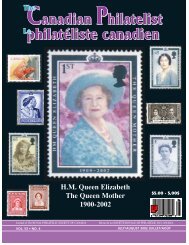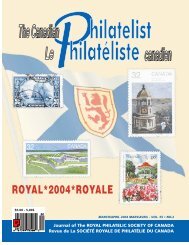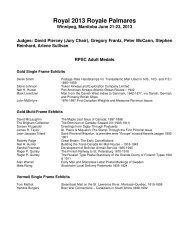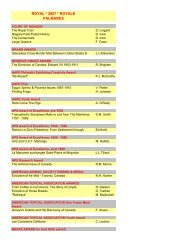Canadian Philatelist Philatéliste canadien - The Royal Philatelic ...
Canadian Philatelist Philatéliste canadien - The Royal Philatelic ...
Canadian Philatelist Philatéliste canadien - The Royal Philatelic ...
Create successful ePaper yourself
Turn your PDF publications into a flip-book with our unique Google optimized e-Paper software.
Figure 5. Figure 6. Figure 7. Figure 8.<br />
Japanese postal history<br />
Figure 5 was sent by Hisashi Yanagawa of the<br />
5th Section, 1st Platoon, 3rd Company, Infantry 1st<br />
Regiment, Imperial Guards, 1st Army Manchuria<br />
on May 22, 1904. It was addressed to Tetsugo<br />
Tomizuka of the 3rd Platoon, 8th Company, Infantry<br />
29th Regiment, Field Army, Manchuria. This letter<br />
was written just before the battle of Nan-shan<br />
(Map 2), which began on May 24, 1904.<br />
Figure 6 shows a cover that has been censored<br />
and with the cachet of ‘Military Mail’ from the 2nd<br />
Army in Manchuria to Japan with the postmark<br />
of the 2nd Army FPO No. 4 dated August 9, 1904.<br />
This cover is a typical Redband cover as used by<br />
the Chinese people.<br />
Figure 7 is a 1904 postal stationery card showing<br />
an unusual 1½ sen card for free military mail. It was<br />
sent by K. Yasuda of the Infantry 35th Regiment,<br />
9th Division, 3rd Army, Manchuria and postmarked<br />
with the 3rd Army FPO 4, on September<br />
28, 1904. <strong>The</strong> addressee was S. Katayama, Reserve<br />
Infantry 35th Regiment, Kanazawa-shi, Japan. <strong>The</strong><br />
3rd Army eventually captured Port Arthur in<br />
December 1904 after fighting for more than a<br />
month for the two main hills.<br />
Figure 8 is a postcard from a Japanese officer,<br />
Major Gene Semba, of the 31st Brigade, 16th<br />
Division, 4th Army Manchuria. <strong>The</strong> postmark is of<br />
the 4th Army Field Post Office, and dated September<br />
29, 1904. It was addressed to First Class Medical<br />
Doctor Akaba, Infantry Unit,<br />
Peking Garrison, China, with<br />
a receiving mark of the IJPO<br />
(Imperial Japanese Post Office)<br />
on September 26, 1905. <strong>The</strong><br />
Japanese Garrison was located<br />
in Peking during and after the<br />
Boxer Rebellion (1900-1901),<br />
and the Imperial Japanese<br />
Post Office was to be found at<br />
the Japanese Legation in the<br />
Legation Quarter of Peking.<br />
It can be seen from the postmarks<br />
that the Japanese system<br />
of displaying the date is to put<br />
the year first followed by the<br />
100 • the CP / le PC • MA06
















